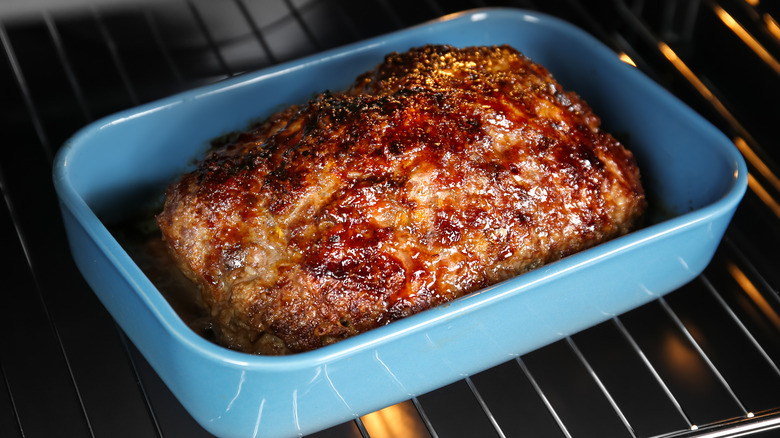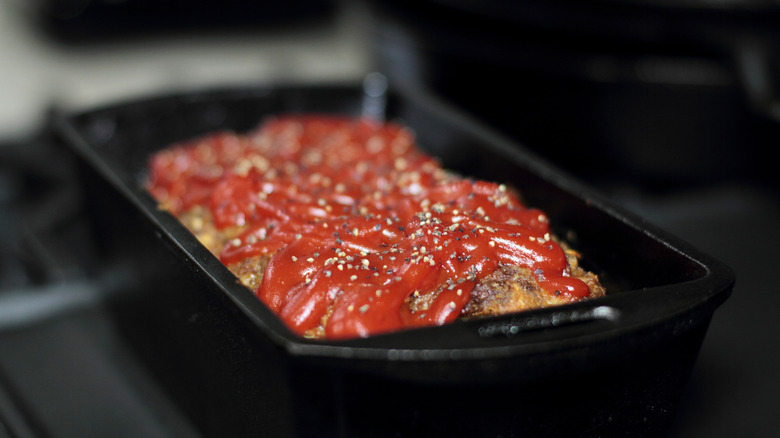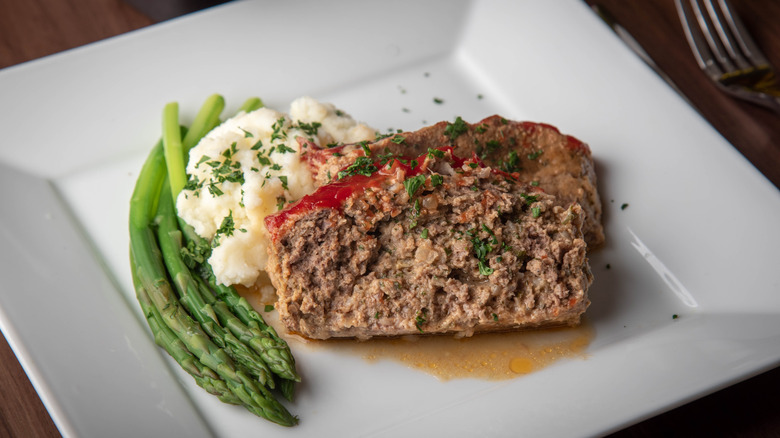The Biggest Meatloaf Mistake You're Making
Meatloaf is the ultimate comfort food, especially when you add some gravy and mashed potatoes. Whether it's breadcrumbs vs. crackers, sauce or no sauce, straight-up beef or a mixture of meats, there are seemingly endless variations and add-ons to meatloaf that make your family's recipe "the best." And while your recipe is probably terrific, there might be one big mistake you're making that's preventing it from being truly delicious.
It's a well-known fact that it's important to let whole muscle meats such as steaks, roasts, and pork loins rest after removing them from a heat source. But did you know that the same rule holds true for meatloaf? Whether you use ground beef, turkey, pork, veal, or any combination thereof in your 'loaf, it's important to give it a rest before cutting slices and serving. Resting meatloaf results in a juicier meatloaf and one that won't fall apart when you slice it.
Cook's Illustrated explains the science, noting that the juices in raw meat are contained in structures within the muscle called myofibrils. When meat is cooked, these proteins contract and some of the liquid is squeezed out. By allowing the meat to rest away from the heat (Cook's Illustrated recommends about five minutes), you give the proteins a chance to reabsorb some of those wonderful, tasty juices that make the meal so delectable. On the other hand, cutting into meat or meatloaf too quickly can result in a runoff of those liquids and may make your meatloaf drier.
Loaf pan or free-form?
Discussions of how to make the tastiest meatloaf ultimately lead to the question of whether it's best to bake your meatloaf in a loaf pan or free-form on a baking sheet. There are advantages to each method, but really it comes down to a matter of taste (via Chowhound). A free-form meatloaf exposes more surface area to the direct heat from the oven and creates more of that crunchy, nicely-browned crust that many people love. Meatloaf made in a loaf pan, however, corrals more of the juices and fat, resulting in a moister, some say "steamed" texture (via the Food Network). Think "school cafeteria" meatloaf, says Today. Not that it's necessarily a bad thing! No matter which method you choose, resting is still important.
If you use a loaf pan, is it better to let it rest in the pan after cooking or remove it? Cooking The Amazing suggests beginning the cooking process by lining your pan with a "sling" of aluminum foil. Then, they advise, allow your meatloaf to rest in the lined pan for 15 minutes after baking. Then, lift the meatloaf out of the pan by grabbing the foil sling and tilt it to drain off the excess fat. Alternatively, Cook's Info advises removing the meatloaf from the pan right after removing it from the oven and immediately transferring it to a cooling rack and allow it to rest there. This will rid your meatloaf of excess fat while still allowing the juices to be reabsorbed.
Getting the perfect temperature
When it comes to their meats, some people are skeptical about resting. After all, people like their hot foods hot, and some equate "resting" with "cooling."
It's true that if too much heat escapes, your meatloaf will cool to an unappetizing temperature. But it's important to note that the temperature of cooked meats actually continues to rise after they are removed from their heat source. In fact, according to ThermoWorks, the temperature of meats rises 3 to 4 degrees during the resting phase.
If you want to preserve as much heat as possible, keep your meatloaf in or on its pan during the resting phase, as opposed to moving it to a rack to drain. Similarly, don't plate your meatloaf on its serving dish until it's fully rested. This will prevent the heat from transferring from the meat to the dish. Finally, tent some aluminum foil over your meatloaf to conserve some of the heat but still allow air circulation. Securing foil tightly over the meatloaf will steam and soften your nice, crispy surface.
The Spruce Eats offers additional tips for juicy meatloaf. First, bake with low heat, about 325 F. Second, use a meat thermometer and remove your meatloaf from the oven when it reaches 155 F to 160 F. Remember, the temperature will continue to rise while the meatloaf is resting, so this is the time to put on the brakes. Ready to try a delicious meatloaf recipe yourself? Check out this twist on Ina Garten's meatloaf or this Cracker Barrel copycat recipe. (Just don't forget to let them rest!)


